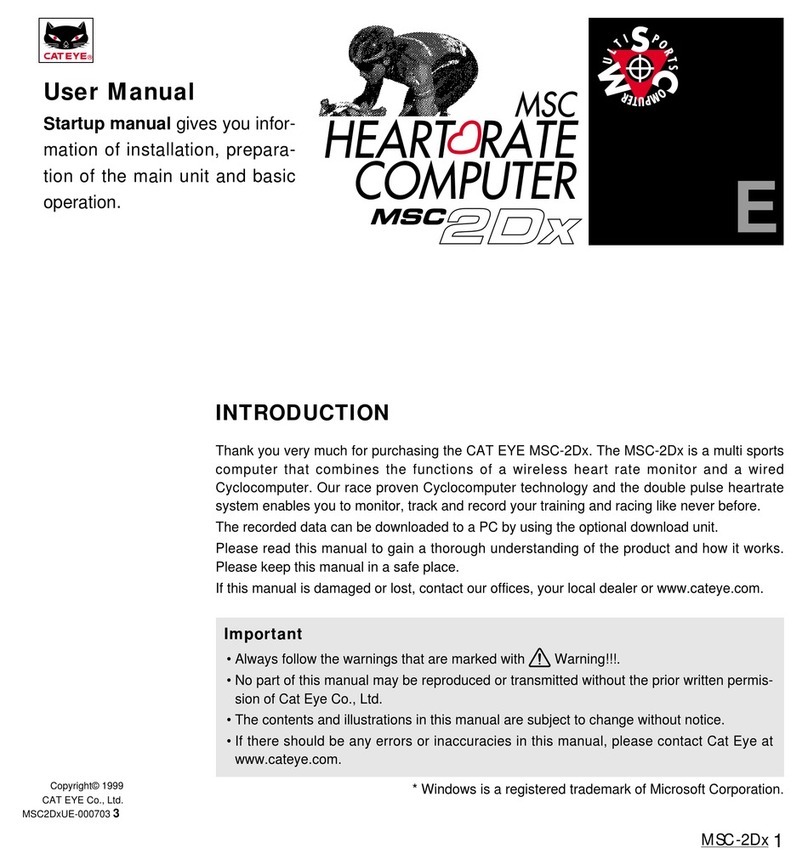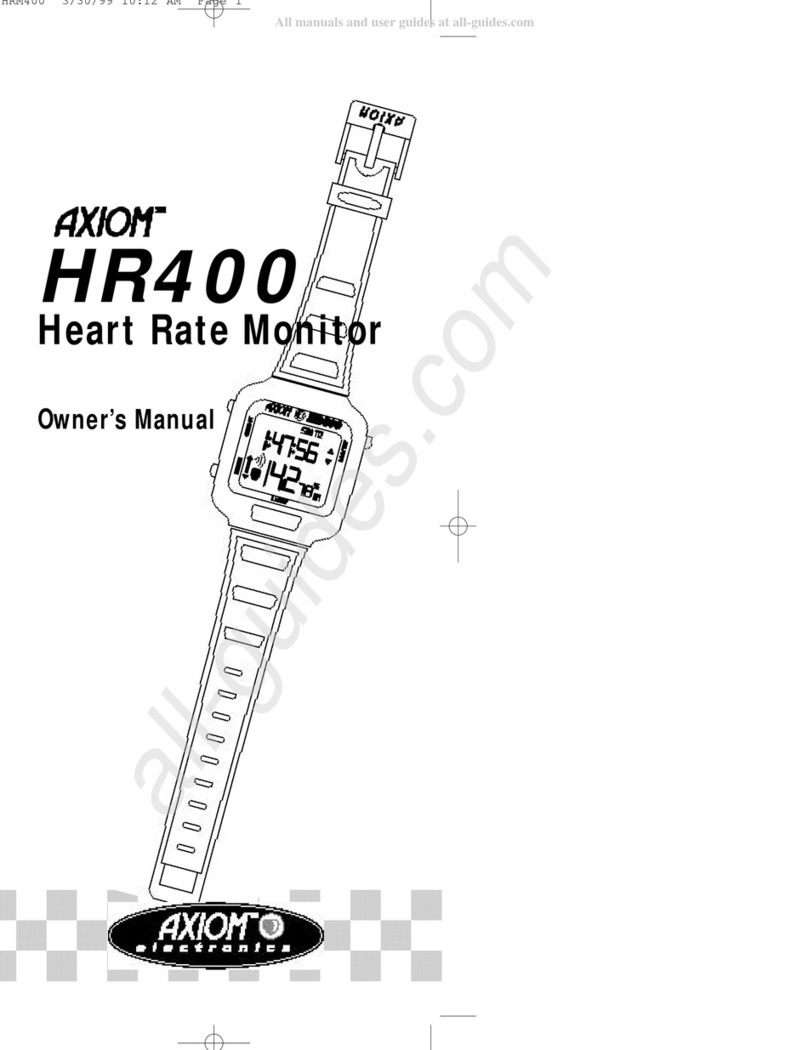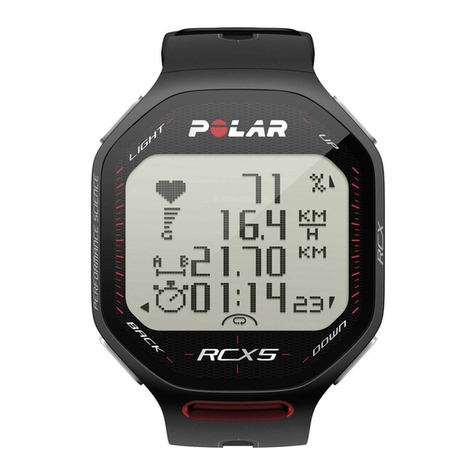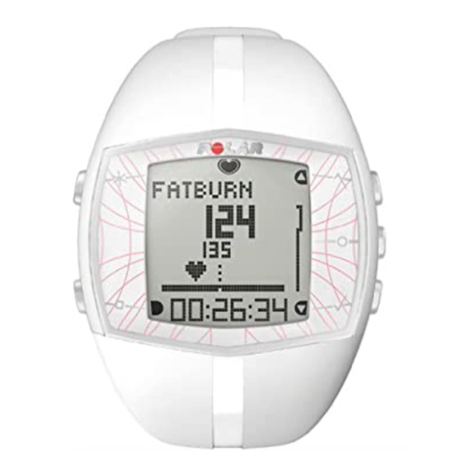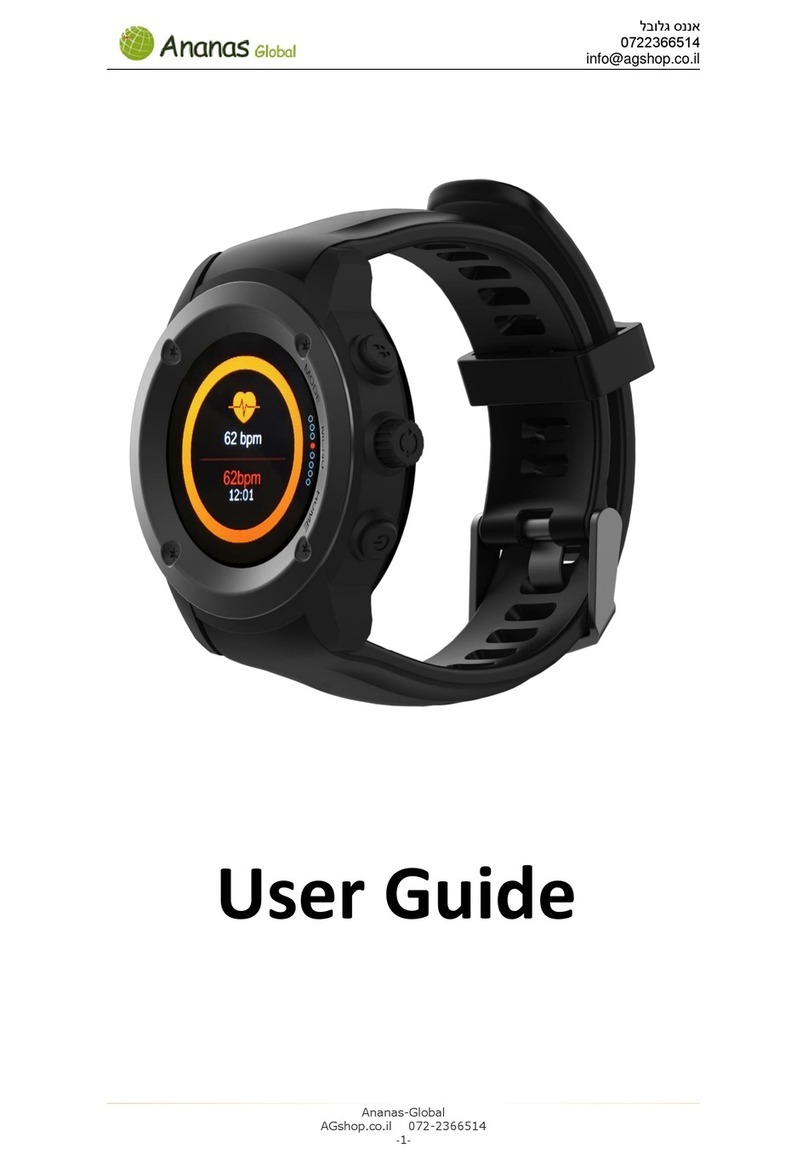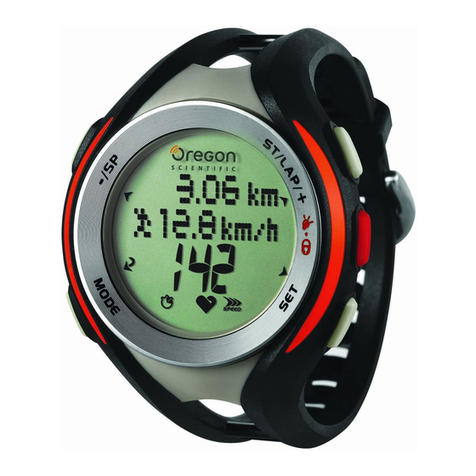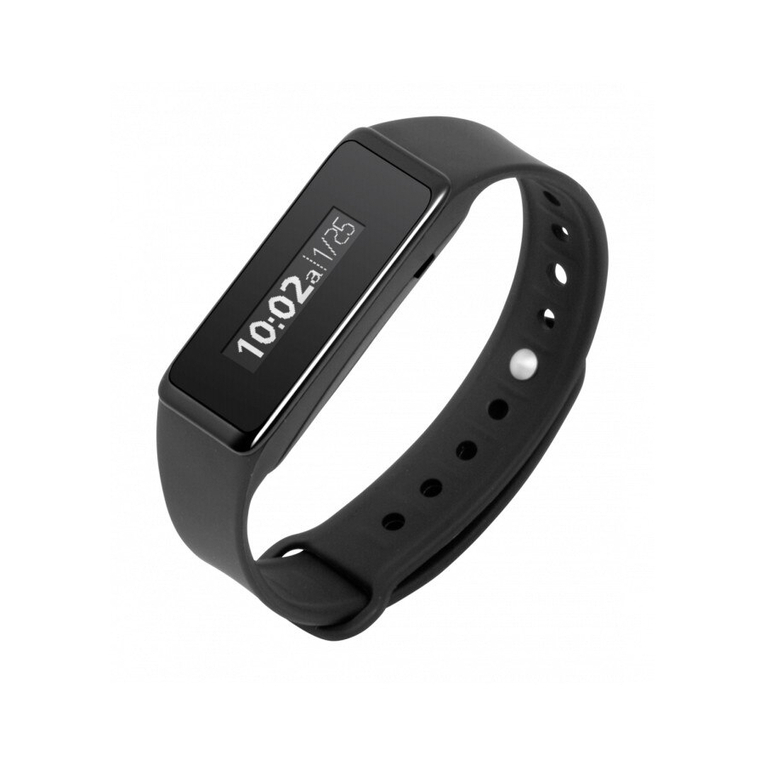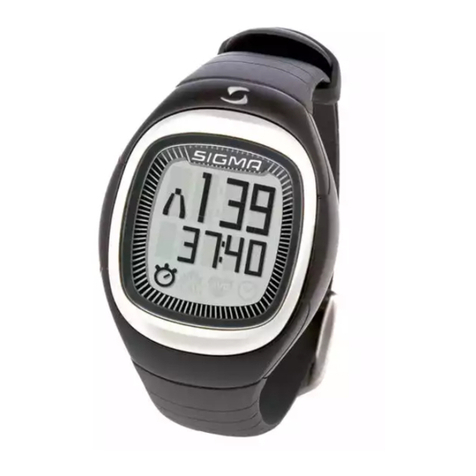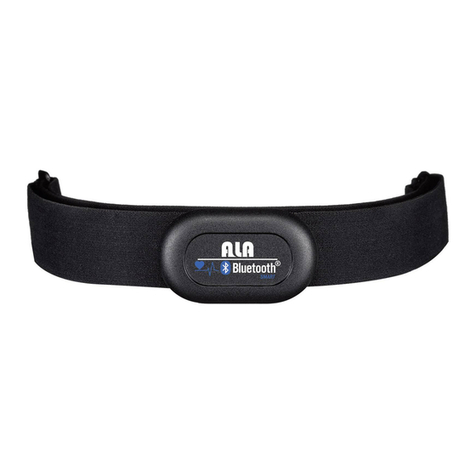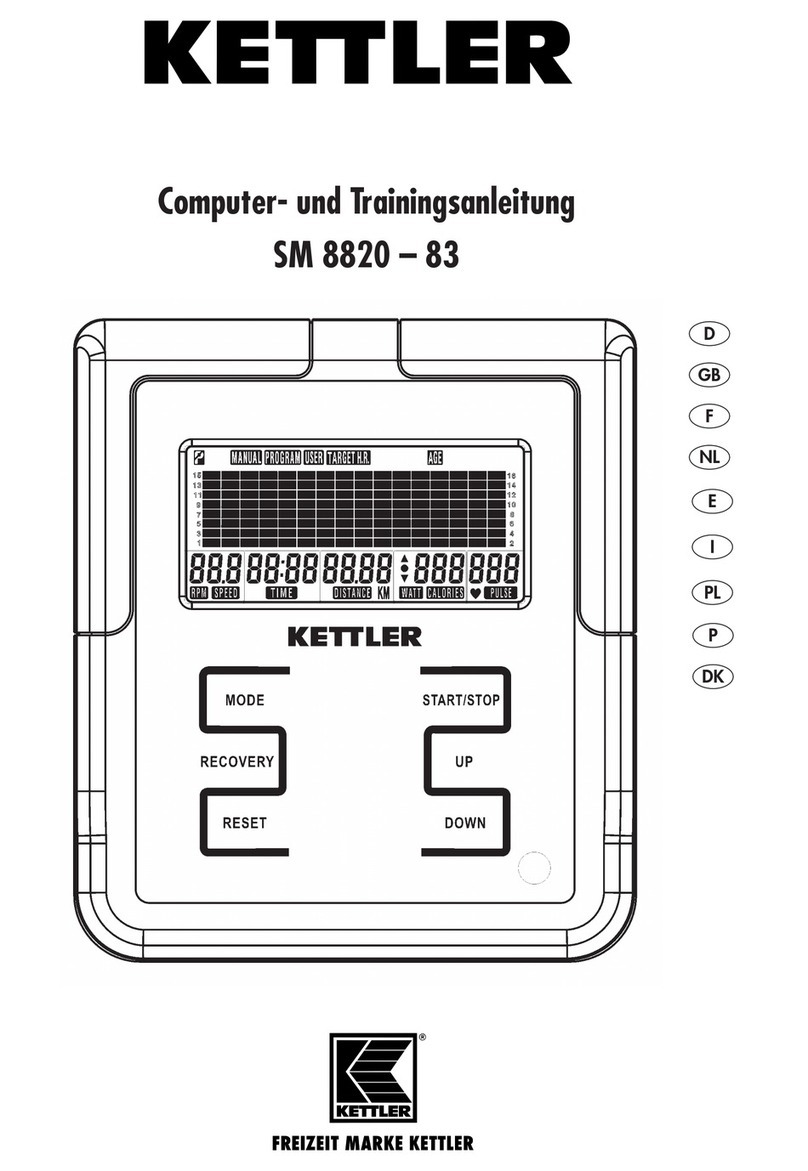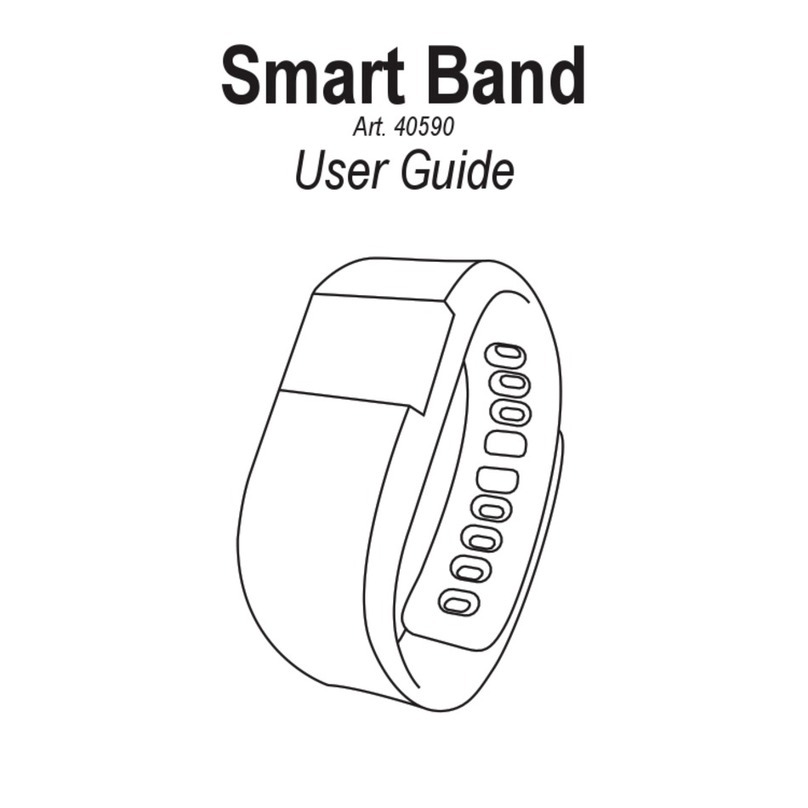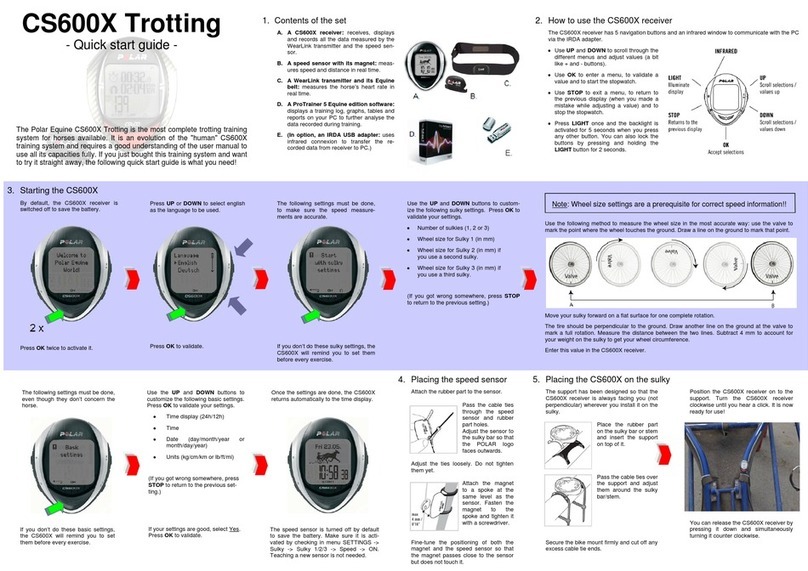getemed VitaGuard VG2100 User manual

VitaGuard®VG2100
Apnea and Heart Rate Monitor
Operating instructions


Who should read which sections in these oper-
ating instructions?
The sections 3to 7coloredblue atthetop ofthepage and in
the table of contents are intendedspecifically for caregivers
without medical background knowledge.
The other sections are intended in particular for doctors and
qualified medical staff.
1General view and list of accessories
2Intended use
3Safety
4Description
5Steps before and after monitoring
6Preparing for heart rate and apnea monitoring
7Alarms, displays, and views during monitoring
8Alarm and monitor settings
9Information for the doctor and qualified medical staff
10 Algorithms and measuring principles
11 Evaluating stored data on a PC
12 Specifications
13 Table of figures
NOTE Words and passages in small capitals in these operating
instructions also appearon the display.


Table of contents
Table of contents
1General view and list of accessories ...................................... 11
2Intended use .......................................................................................... 14
2.1 Label on the back of the device .............................................................. 14
2.2 Symbols and warnings .............................................................................. 15
2.3 Indications .................................................................................................... 16
2.4 VitaGuard® modes of operation ............................................................ 16
2.5 Intended use and performance .............................................................. 17
2.6 Limitations on VitaGuard®’s intended use ......................................... 18
2.6.1 Obstructive apneas are not detected ................................... 18
2.6.2 Limitations of the heart rate and central apnea
monitor ......................................................................................... 18
2.7 Information for the doctor on these operating instructions ......... 19
3Safety .......................................................................................................... 20
3.1 Caregivers’ tasks ......................................................................................... 20
3.2 Allergy risks to patients ............................................................................ 22
3.3 Possible external interference to monitoring .................................... 22
3.3.1 Installation and environment ................................................ 22
3.3.2 Noise risks to monitoring ........................................................ 23
3.3.3 Electrostatic interference ........................................................ 24
3.3.4 Electromagnetic interference ................................................. 24
3.4 Safety with approved accessories only ................................................ 25
3.5 Handling patient cables ........................................................................... 26
3.6 Power supply reliability ............................................................................ 26
3.6.1 Battery voltage indicator ......................................................... 28
3.6.2 Interruptions to the power supply ........................................ 28
3.6.3 Using the rechargeable block battery .................................. 29
3.7 Safety with proper maintenance only .................................................. 30
3.7.1 Cleaning VitaGuard® and accessories ................................. 30
3.7.2 Checking and cleaning the battery terminals ................... 31
3.8 Disposing of non-rechargeable batteries, the device, and
accessories .................................................................................................... 31

Table of contents
4Description .............................................................................................. 33
4.1 Power supply ............................................................................................... 34
4.1.1 Power failure with inserted batteries .................................. 35
4.1.2 Power failure without batteries ............................................ 35
4.1.3 Replacing batteries .................................................................... 36
4.1.4 Using the automobile power supply adapter ................... 37
4.2 VitaGuard® connections .......................................................................... 38
4.2.1 Patient cable for electrodes .................................................... 38
4.2.2 Power adapter ............................................................................. 39
4.2.3 Sound outlet (no socket) .......................................................... 39
4.2.4 USB port ........................................................................................ 40
4.2.5 AUX port ....................................................................................... 40
4.3 Membrane key panel ................................................................................ 41
4.3.1 Direction keys .............................................................................. 42
4.3.2 <Enter> key ................................................................................... 42
4.3.3 <Esc> key ....................................................................................... 42
4.4 Color LEDs (Light Emitting Diodes) ....................................................... 43
4.4.1 Alarm LED ..................................................................................... 43
4.4.2 Heart and respiration LEDs ..................................................... 43
4.4.3 Power supply and battery LEDs ............................................. 44
4.5 The display ................................................................................................... 44
5Steps before and after monitoring ......................................... 46
5.1 Summary of steps before monitoring .................................................. 46
5.2 Switching on ................................................................................................ 47
5.3 Switching off ............................................................................................... 48
5.4 Summary of steps after monitoring ..................................................... 48
6Preparing for heart rate and apnea monitoring ........... 49
6.1 Safety information when monitoring heart rate and apnea ........ 49
6.2 Connecting electrodes, the patient cable, and VitaGuard® .......... 52
6.3 Technical alarm from the electrode contact monitor ..................... 52
6.4 Determining the optimal electrode configuration .......................... 53
6.4.1 ECG lead, electrode color coding ........................................... 53
6.4.2 Optimizing the heart and respiration signals –
signal amplitudes in View 1 ................................................... 54

Table of contents
6.5 Checking the basal impedance .............................................................. 55
7Alarms, displays, and views during monitoring ............ 57
7.1 Alarm test ..................................................................................................... 57
7.2 Heart rate values based on age groups .............................................. 57
7.3 Alarm message priorities in the status line ........................................ 58
7.4 Physiological and technical alarms ....................................................... 58
7.5 Differentiating physiological and technical alarm signals ............ 59
7.6 Acoustic information signals .................................................................. 60
7.6.1 Information signals from the alarm unit next to the
display ............................................................................................ 60
7.6.2 Information signals from the sound aperture
between the sockets ................................................................. 60
7.7 The visual alarm signals ........................................................................... 60
7.8 Status line displays .................................................................................... 60
7.9 Heart rate and apnea monitoring ......................................................... 62
7.9.1 Heart rate alarms ....................................................................... 62
7.9.2 Apnea alarms ............................................................................... 62
7.9.3 Technical heart rate and apnea alarms ............................... 63
7.10 Alarm messages – meanings and other information ...................... 63
7.10.1 Order of equal-priority alarm conditions ............................ 63
7.10.2 Table of physiological alarm messages ............................... 63
7.10.3 Table of technical alarm messages ....................................... 65
7.11 Table of information messages .............................................................. 67
8Alarm and monitor settings ........................................................ 68
8.1 Safety instructions for the alarm settings .......................................... 68
8.2 Summary of views and menus ............................................................... 69
8.3 Additional views ......................................................................................... 69
8.3.1 View 2 – Large data presentation and waveforms .......... 70
8.3.2 View 3 – Smaller data presentation and waveforms ...... 70
8.4 Changing the settings ............................................................................... 70
8.5 System menu – general settings ............................................................ 72
8.5.1 \ Screen saver (Off/ On) ......................................................... 72
8.5.2 \LCDbrightness ....................................................................... 72
8.5.3 \LCDcontrast ........................................................................... 72
8.5.4 \ Signal beep tone ..................................................................... 73

Table of contents
8.5.5 \ Alarm tone pitch ................................................................... 73
8.5.6 \RS232format ........................................................................... 73
8.5.7 \ Settings protection On, Limited, Off ............................. 74
8.6 Heart rate display and menu ................................................................ 75
8.6.1 Heart rate display ..................................................................... 75
8.6.2 Heart rate menu – alarm settings (Settings
protection Limited) .................................................................. 75
8.7 Respiration display and menu .............................................................. 77
8.7.1 Respiration display ................................................................... 77
8.7.2 Respiration menu – alarm settings (Settings
protection Limited) .................................................................. 78
9Informationforthedoctorandqualifiedmedicalstaff ..... 79
9.1 Safety instructions ..................................................................................... 79
9.1.1 Preparing for a new patient .................................................... 79
9.1.2 Connections to the USB and AUX ports .............................. 81
9.1.3 VitaGuard® and other medical devices ............................... 81
9.2 Info display .................................................................................................. 82
9.2.1 \ Last status messages ............................................................ 82
9.2.2 \ General ...................................................................................... 83
9.2.3 \ Measurements: HR & Resp. .................................................. 84
9.2.4 \ Settings: Heart rate .............................................................. 85
9.2.5 \ Settings: Apnea monitor .................................................... 85
9.2.6 \ Memory/ Internet ................................................................. 86
9.2.7 \Versions .................................................................................... 86
9.3 Settings in the System menu (Settings protection Off) .............. 87
9.3.1 Changing multiple-component settings ............................ 87
9.3.2 \ Operating area: Home or Clinic ........................................ 88
9.3.3 \Admitnewpatient– restoring factory settings ........... 88
9.3.4 \Pre-and Post-alarm time .................................................... 90
9.3.5 \ Alarm mute time .................................................................... 90
9.3.6 \Date/time ................................................................................. 90
9.3.7 \ Language .................................................................................. 91
9.3.8 \Analoginput1 + 2 ................................................................ 91
9.3.9 \ Interval recording ............................................................... 91
9.4 Data storage functions ............................................................................. 91

Table of contents
9.5 Event storage .............................................................................................. 92
9.5.1 Silent alarm limits ................................................................... 94
9.5.2 Manual data storage or Transmit data .......................... 94
9.5.3 Summary of stored Events ...................................................... 95
9.6 Trend storage .............................................................................................. 96
9.7 Long term storage over eight hours .................................................... 96
9.8 Protocol storage of operating and device data ............................. 96
9.9 Summary of stored signals and data .................................................... 97
9.10 Settings in the Heart rate menu (Settings protection Off) ....... 98
9.11 Changing the ECG leadfor signal optimization ...................................101
9.12 Settings in the Respiration menu (Settings protection Off) .....103
10 Algorithms and measuring principles ..................................105
10.1 Alarm condition and report delays ........................................................105
10.1.1 Alarm condition delay for the heart rate ............................105
10.1.3 Alarm condition delay for respiration ..................................106
10.1.4 Alarm report delays ...................................................................106
10.2 Measuringprinciple fortheheartrate monitor ...................................107
10.3 Measuring principle for the apnea monitor .......................................108
11 Evaluating stored data on a PC .................................................110
12 Specifications ........................................................................................112
12.1 General ..........................................................................................................112
12.2 Heart rate monitor .....................................................................................114
12.3 Apnea monitor ............................................................................................114
12.4 Intervals for calculating average values in the Info mask .............115
12.5 Memory .........................................................................................................115
12.6 Ports ................................................................................................................115
12.7 Miscellaneous ..............................................................................................116
12.8 Selection of applied standards ...............................................................117
13 Table of figures .....................................................................................119

Table of contents

General view and listof accessories 11
1 General view and list of accessories
The general view shows themonitoring system’smost important
components.
Fig. 1 General view of the monitoring system
External
power adapter
ECG
patient cable ECG
electrodes

12 General view and list of accessories
The accessories listed in the following can be used together with
VitaGuard® andcan be orderedwith the specifiedarticle numbers
from getemed AG or authorized dealers. Please consult getemed AG
or your authorized dealer for other approved accessories.
Product .............................................................................. Article no. / REF
VitaGuard®VG2100 Monitor
complete system ............................................................................ 7311 1022
1 VitaGuard® VG2100 monitor
1 ECG patient cable, 9 neonatal electrodes
1 NA3000-2 external power adapter
1 rechargeable block battery
1 device bag
1 operating instructions,1 quick reference
Transport case
NA3000-2 external power adapter
(110V–240V~/50–60Hz) ............................................................ 7344 1101
NAK3000-2 automobile power supply adapter ................... 7344 1201
Rechargeable block battery ......................................................... 7344 2201
PK1-8P ECG patient cable ............................................................ 7341 1001
Kitty Cat™ neonatal electrodes (PU = 30 pcs) ................................ 70222
Operating instructions (English) ................................................ 7381 1021
Alarm chart(English) ..................................................................... 7383 1021
Device bag ........................................................................................ 7345 1001
VitaGuard® transport case (forthe complete system) ........ 7391 0001
AUX 01 RS232 cable for connectingVitaGuard®
to a serial PC port ........................................................................... 7341 2002
AUX-02 modem cable for connectinga
modem to VitaGuard® .................................................................. 7341 3001

General view and listof accessories 13
AUX-03 cable for connecting an external alarm unit
to VitaGuard® ................................................................................ 7341 5001
AUX-04 cable for connecting VitaGuard®
to a nurse callsystem with 4 kV isolation ............................... 7341 5011
AUX-06 cable forconnecting two external signal sources
to VitaGuard® .................................................................................. 7341 6001

14 Intended use
2 Intended use
This section provides information on the intended use of VitaGuard®
and the limitations of this intended use.
CAUTION Do not attempt to use VitaGuard® for detecting obstruc-
tive apneas.Obstructive apneas, i.e. respiratoryarrest followingan
occluded respiratory tract, are not detected by VitaGuard®. Food
debris or vomit, for example, can occlude the respiratory tract.
The doctor treating the patient is responsible for the application of
VitaGuard®. The specific “Information for thedoctorand qualified
medical staff” can be found on page 79.
getemed AG recommends qualified training for the caregivers in
potentially necessary resuscitationtechniques. Clearingtherespira-
tory tract and the resuscitation of babies and infants require particu-
lar know-how that the treating doctor should communicate to the
caregivers.
2.1 Label on the back of the device
The device label serves as a
unique identifier for Vita-
Guard®. In addition, the label
bears important cautionary
information.
On the device label you will
find the manufacturer’s name
and address as well as the
product and model name. The
serial number of your device is
given next to SN. Fig. 2 Device label on the bottom of the device

Intended use 15
2.2 Symbols and warnings
This symbol warns you that failure to observe these op-
erating instructions can cause death or injury to the pa-
tient.
The book symbol means that you must not use the de-
vice when you are not familiar with the information con-
tained in these operating instructions.
With this CE label and the CE approval number 0197
getemed AG confirms that VitaGuard® complies with all
the pertinent regulationsand in particular the require-
ments in Annex I of the Medical Devices Directive
93/42/EWG and that this has beenapproved by a noti-
fied body (TÜV RheinlandProduct Safety).
This symbol means that the VitaGuard®’s ECG socket is a
typeCF (cardio floating) applicationpart andthat it is
protected against the effects of defibrillation.
The factory symbol shows the year ofmanufacture.
Note the warnings on the device label.
Do not use in explosive atmospheres!
Use theNA 3000-2 power adapter only!
Warning: Do not connect to an electrical socket controlled by a wall
switch!
Only new alkaline batteries (LR6 or AA) must be used when the
device is powered by non-rechargeable batteries! Note the polarity!

16 Intended use
2.3 Indications
VitaGuard® can be used tomonitor patients with, for example, the
following symptoms or treatment:
unstable respiration
life-threatening cardiac dysrhythmia
conspicuous sleep laboratory findings
facial and/ or cervical and thoracic dysmorphia
distinct gastro-esophageal reflux
ataxia
The heart rate andapnea monitor is suitable for adult, pediatric, and
infant patients at home or in rooms used for medical purposes.
The apnea monitor is specifically intended for monitoring central
apneas. Successful apnea monitoring requires a stable underground
and a patient that lies quietly without moving.
2.4 VitaGuard® modes of operation
Depending on the risk group and thelatestdiagnosis, VitaGuard®
allows the treating doctor to combine two monitoring parameters:
heart rate monitoring
apnea monitoring
The doctor can deactivate the apnea monitor in the Respiration
menu.
In addition to the fixed alarm limits for the heart rate monitor, the
doctor or the qualifiedmedical staff can alsoconfigure percentage
deviations as alarm conditions.
The doctor or the qualified medical staff can find all other explana-
tions they may need in the following sections:

Intended use 17
“Settings in the Heart rate menu(Settings protection Off)” on
page 98,
“Settings in the Respiration menu(Settings protection Off)” on
page 103,
2.5 Intended use and performance
The intended use of VitaGuard® is to detect central apneas when the
patient is completely immobile on a stable underground and tomoni-
tor the heart. VitaGuard® is designed for applicationsat home and in
rooms used formedical purposes.VitaGuard®has no therapeutic effect.
VitaGuard® emits an acoustic and visual alarm when no respiration or
movement is detected within a set period, when themeasured heart
rate valuesviolate the setalarm limits for a period also setby the
operator, and/or when no heartbeat has been detected for a set
period. The alarm limits can be set within particular values specified
by VitaGuard®.
Respiration and heart rate are monitored with adhesive ECG elec-
trodes. VitaGuard® determines the heart rate from the ECG signal
detected by the electrodes.
VitaGuard® features an impedance monitor that triggers a technical
alarm whenan electrode exhibits impedance values that are not
compatible with proper operation. This is the case, for example, when
an electrode has become detached.
Physiological data measured for a setperiod before and after an
alarm are stored and can afterwards be evaluated and documented.
VitaGuard® can be operated with theNA3000-2 power adapter (9 V),
the NAK3000-2 automobile power adapter (e.g. in the cigarette
lighter), four non-rechargeable batteries, or a rechargeable block
battery. Non-rechargeable batteries or the rechargeable block battery
serve above all to safeguard the monitor’s functions during a power
failure and to continue monitoring when patients are in transit.

18 Intended use
2.6 Limitations on VitaGuard®’s intended use
Even when operated in accordancewith its intended use, Vita-
Guard® cannot detect all life-threatening situations under certain
unfavorable conditions.
2.6.1 Obstructive apneas are not detected
Obstructive apneas are not detectedby VitaGuard®. The caregiver
may have to remove food debris from the patient’s oral cavity.
Whenan obstructive apnea at the same time triggers a bradycardia
alarm (heart rate toolow), resuscitation measures may need to be
taken.
2.6.2 Limitations of the heart rate and central apnea
monitor
VitaGuard® could misinterpret movements as respiration, e.g. in
ambulances, cars, and prams or when a child is held in the arms. For
this reason central apneas can be detected only when the patient is
sleeping or is lying still, does not move, and is not being moved.
The heart rate can be monitored with electrodes also when the
patient is moving, but sudden, vigorous movements can adversely
affect themeasuring accuracy.
A false heart rate is displayed duringventricular fibrillation orwhen
the heart rate exceeds 270 beats per minute.

Intended use 19
2.7 Information for the doctor on these
operating instructions
In full knowledge of these operating instructions, the treating doc-
tor must decide:
whether the caregivers have to be trained in the performance of
resuscitation measures,
how the caregivers can be best prepared for monitoring and
above all for themeasures that must be taken in the event of an
alarm,
which View should be displayed
Information on Settings protection that sets the display modes and
user configurations can be found on page 73.
“Information for the doctor and qualified medical staff” is found on
page 79.

20 Safety
3 Safety
The responsible doctor decides whether the caregivers are able to
use VitaGuard® for monitoring and whether they can implement
appropriate measures in the event ofan alarm.
3.1 Caregivers’ tasks
With “caregivers”wemean those persons who are responsible during
monitoring for the monitored patient’s well-being, for example:
parents or other members of the family,
babysitters, when they too have been thoroughly prepared for the
situation,
nurses and other medically trained staff.
Observein particular theinformationin thosesections of theoper-
ating instructions that,like here, address you directly.
Observe the extensive safety instructions at the beginning of the
section “Preparing for heart rate and apnea monitoring” on page 49.
VitaGuard® has no therapeutic effect. You may have to implement
resuscitation measures in the event of an alarm.
The potential applications of VitaGuard® for high-risk patients are
so many and diverse that we are unable to give any specific instruc-
tions on procedure in the event of an alarm. It is the doctor’s task to
inform high-risk patients and their caregivers in detail on the correct
procedure in this case.
An alarmchartis available from getemed AG whenmonitoring
children. This alarm chart presents a sequence of activities that are
considered suitable by many medical specialists and pediatricians.
Do not attempt to use VitaGuard® on more than one patient at a
time.
Other manuals for VitaGuard VG2100
1
Table of contents
